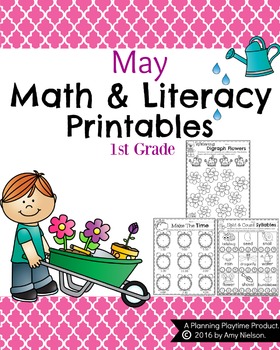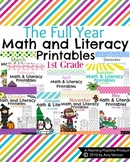1st Grade Math and Literacy Printables - May
Planning Playtime
25.9k Followers
Grade Levels
1st, Homeschool
Subjects
Resource Type
Standards
CCSS1.MD.A.2
CCSS1.MD.B.3
CCSS1.MD.C.4
CCSS1.NBT.B.2a
CCSS1.NBT.B.2b
Formats Included
- PDF
Pages
28 pages
Planning Playtime
25.9k Followers
What educators are saying
Loved the range of skills and concepts that this resource targeted. It was well aligned to our living things unit.
Also included in
- 1st Grade Math and Literacy Printables - The Full Year BundleCCSS This bundle of 1st grade math and literacy printable worksheets are a No Prep, fun way to start out the school year. The 250 worksheets are ready to be copied and passed out. I created them in black and white to save on ink when yoPrice $30.00Original Price $37.50Save $7.50
Description
1st Grade Math and Literacy Printables - May
This is and adorable set of 25 1st Grade Math and Literacy printables for spring. These worksheets are a No Prep, fun way to work on common core concepts in May. All of the sheets are ready to be copied and passed out, and even better, I created them in black and white to save you money on ink.
**BUY THE FULL YEAR BUNDLE AND SAVE $$**
Teachers are using these printables as morning work, homework, math and literacy center activities, and as part of their lesson plans. The cute May and spring themes include spring gardens, flowers, bugs, and more.
Here is a list of the first grade worksheets in this set.
* Odd or Even Addition
* Place Value Ladybugs
* In the Garden Place Value
* Commutative Property of Addition
* Making 10 Addition and Subtraction
* Spring Flowers - Missing Parts Equations
* Flower Garden Measurement
* Spring Garden Word Problems
* True or False Equations
* Make the Time - Draw the Hands on the Clocks
* Common or Proper Noun Pencils
* Watering Can Adjectives
* Split and Count Syllables
* Bees to Flowers Blends
* Number Words or Color Words Find and Count
* Past, Present, and Future Verbs
* Watering Digraph Flowers
* Beginning, Middle, and Ending Sounds
* When We Go Shopping - Narrative Writing Prompt
* My Opinion About Ice Cream - Opinion Writing Prompt
* How to Plant a Garden - Informative Writing Prompt
* CVC or CVCe Words
* Long or Short Vowel Bug Hunt
* Planting Pots - Pronoun and Verb Tenses
* Bug Spin and Write Inflectional Endings
I hope you find these worksheets engaging and helpful in your classrooms this spring. Let me know if you have any questions. I am always happy to help.
Thank you!
__________________________________________________________________________________________________
You might also like these products:
More Great 1st Grade Math and Literacy Printables
Lots of Great Writing Prompts
Addition and Subtraction Word Problems
Kindergarten Reading Comprehension Passages
_________________________________________________________________________________________________
*Tips for Buyers
Get credit towards future purchases at TeachersPayTeachers by leaving feedback on purchased items. Go to My TPT, and click on my purchases. After leaving a review on your purchase item, you will receive one credit per dollar spent on that item.
Make it easier to find new products from the sellers you like. Just click on the Follow Me link below their name to keep informed of their new releases and sales they may be throwing.
This is and adorable set of 25 1st Grade Math and Literacy printables for spring. These worksheets are a No Prep, fun way to work on common core concepts in May. All of the sheets are ready to be copied and passed out, and even better, I created them in black and white to save you money on ink.
**BUY THE FULL YEAR BUNDLE AND SAVE $$**
Teachers are using these printables as morning work, homework, math and literacy center activities, and as part of their lesson plans. The cute May and spring themes include spring gardens, flowers, bugs, and more.
Here is a list of the first grade worksheets in this set.
* Odd or Even Addition
* Place Value Ladybugs
* In the Garden Place Value
* Commutative Property of Addition
* Making 10 Addition and Subtraction
* Spring Flowers - Missing Parts Equations
* Flower Garden Measurement
* Spring Garden Word Problems
* True or False Equations
* Make the Time - Draw the Hands on the Clocks
* Common or Proper Noun Pencils
* Watering Can Adjectives
* Split and Count Syllables
* Bees to Flowers Blends
* Number Words or Color Words Find and Count
* Past, Present, and Future Verbs
* Watering Digraph Flowers
* Beginning, Middle, and Ending Sounds
* When We Go Shopping - Narrative Writing Prompt
* My Opinion About Ice Cream - Opinion Writing Prompt
* How to Plant a Garden - Informative Writing Prompt
* CVC or CVCe Words
* Long or Short Vowel Bug Hunt
* Planting Pots - Pronoun and Verb Tenses
* Bug Spin and Write Inflectional Endings
I hope you find these worksheets engaging and helpful in your classrooms this spring. Let me know if you have any questions. I am always happy to help.
Thank you!
Amy
__________________________________________________________________________________________________
You might also like these products:
More Great 1st Grade Math and Literacy Printables
Lots of Great Writing Prompts
Addition and Subtraction Word Problems
Kindergarten Reading Comprehension Passages
_________________________________________________________________________________________________
*Tips for Buyers
Get credit towards future purchases at TeachersPayTeachers by leaving feedback on purchased items. Go to My TPT, and click on my purchases. After leaving a review on your purchase item, you will receive one credit per dollar spent on that item.
Make it easier to find new products from the sellers you like. Just click on the Follow Me link below their name to keep informed of their new releases and sales they may be throwing.
__________________________________________________________________________________________________
Total Pages
28 pages
Answer Key
N/A
Teaching Duration
N/A
Report this resource to TPT
Reported resources will be reviewed by our team. Report this resource to let us know if this resource violates TPT’s content guidelines.
Standards
to see state-specific standards (only available in the US).
CCSS1.MD.A.2
Express the length of an object as a whole number of length units, by laying multiple copies of a shorter object (the length unit) end to end; understand that the length measurement of an object is the number of same-size length units that span it with no gaps or overlaps.
CCSS1.MD.B.3
Tell and write time in hours and half-hours using analog and digital clocks.
CCSS1.MD.C.4
Organize, represent, and interpret data with up to three categories; ask and answer questions about the total number of data points, how many in each category, and how many more or less are in one category than in another.
CCSS1.NBT.B.2a
10 can be thought of as a bundle of ten ones - called a “ten.”
CCSS1.NBT.B.2b
The numbers from 11 to 19 are composed of a ten and one, two, three, four, five, six, seven, eight, or nine ones.






